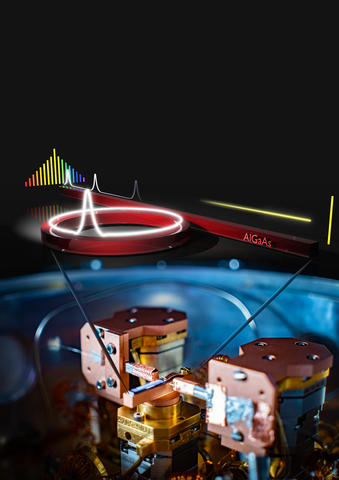(Custom-Built to Ready-Made Researchers lead project that revollutioniazes photonic systems)
2020/6/17 アメリカ合衆国・カリフォルニア大学サンタバーバラ校(UCSB)
・ UCSB、カリフォルニア工科大学(Caltech)およびスイス・ローザンヌ工科大学(EPFL)が、複雑なオプティカルシステムを簡素化し、シリコンフォトニックチップに統合した集積光マイクロコムを開発。
・ シリコンフォトニクス分野は、UCSB と Intel による 15 年前のシリコンレーザー技術の確立後進展を続けている。現在 Intel は、データセンター用のシリコンフォトニックトランシーバを全世界に供給している。
・ 今日のインターネットはフォトニクスで駆動されているが、増加するデータ通信量により、個々のシリコンフォトニックチップが処理できるデータレートの要件も増大している。この課題に最も効率的に対処できるのは、より多くのレーザー色でより多量の情報を運ぶマルチカラー・レーザー光による情報伝送技術。
・ しかし、現在の集積レーザーが発振できるのは一度に一色のみ。より多量の情報の処理にはチップに 50 以上のレーザーが必要となるが、コストとエネルギー効率の課題が伴う。さらに、ノイズや熱によるレーザー光周波数の僅かな変動や、マルチレーザーの周波数の混信の課題もある。
・ 今回、これらの課題を世界最小のコム・ジェネレーターの実証により解決。分布帰還型レーザーと窒化シリコンのフォトニックチップ(LIGENTEC が商用化・EPFL が提供)で構成される、多色を発するシンプルな構造で、システム全体がマッチ箱よりも小さなパッケージに納まる。
・ また、従来のシステムに比べ低コスト・低エネルギー消費で、ソリトンと呼ばれるコヒーレントなコム状態をオンデマンドで容易に生成する。このプロセスは、周波数やエネルギーの調整を要し困難であった。ポンプレーザーと共振器の統合が生み出す相互作用が自己注入同期型の高度な連結システムを形成し、共振器内を循環して光周波数コムを発生させるソリトンを生成する。
・ 本研究結果は、大型で高価な従来の光周波数コムを研究室から実社会へ送り出す重要なステップ。従来のシリコンチップ製造への導入と製造コストの大幅な低減が期待できる。
・ 通信関連製品のマルチカラー・レーザー光源や、腕時計に納まる手頃な価格の光格子時計、よりコンパクトで高感度の GPS レシーバ等、多様なアプリケーションにおける新たな用途を提案し、フォトニクス分野と日常生活に変革をもたらすものと考える。
・ 本 研 究 に は 、 米 国 防 高 等 研 究 計 画 局 (DARPA) の Direct On-Chip Digital Optical Synthesizer(DODOS)プログラム(フォトニック集積回路による光シンセサイザーを実証)が資金を提供した。
URL: https://www.news.ucsb.edu/2020/019939/custom-built-ready-made
<NEDO海外技術情報より>
(関連情報)
Nature 掲載論文(アブストラクトのみ:全文は有料)
Integrated turnkey soliton microcombs
URL: https://www.nature.com/articles/s41586-020-2358-x
Abstract
Optical frequency combs have a wide range of applications in science and technology1. An important development for miniature and integrated comb systems is the formation of dissipative Kerr solitons in coherently pumped high-quality-factor optical microresonators. Such soliton microcombs have been applied to spectroscopy, the search for exoplanets, optical frequency synthesis, time keeping and other areas. In addition, the recent integration of microresonators with lasers has revealed the viability of fully chip-based soliton microcombs. However, the operation of microcombs requires complex startup and feedback protocols that necessitate difficult-to-integrate optical and electrical components, and microcombs operating at rates that are compatible with electronic circuits—as is required in nearly all comb systems—have not yet been integrated with pump lasers because of their high power requirements. Here we experimentally demonstrate and theoretically describe a turnkey operation regime for soliton microcombs co-integrated with a pump laser. We show the appearance of an operating point at which solitons are immediately generated by turning the pump laser on, thereby eliminating the need for photonic and electronic control circuitry. These features are combined with high-quality-factor Si3N4 resonators to provide microcombs with repetition frequencies as low as 15 gigahertz that are fully integrated into an industry standard (butterfly) package, thereby offering compelling advantages for high-volume production.




